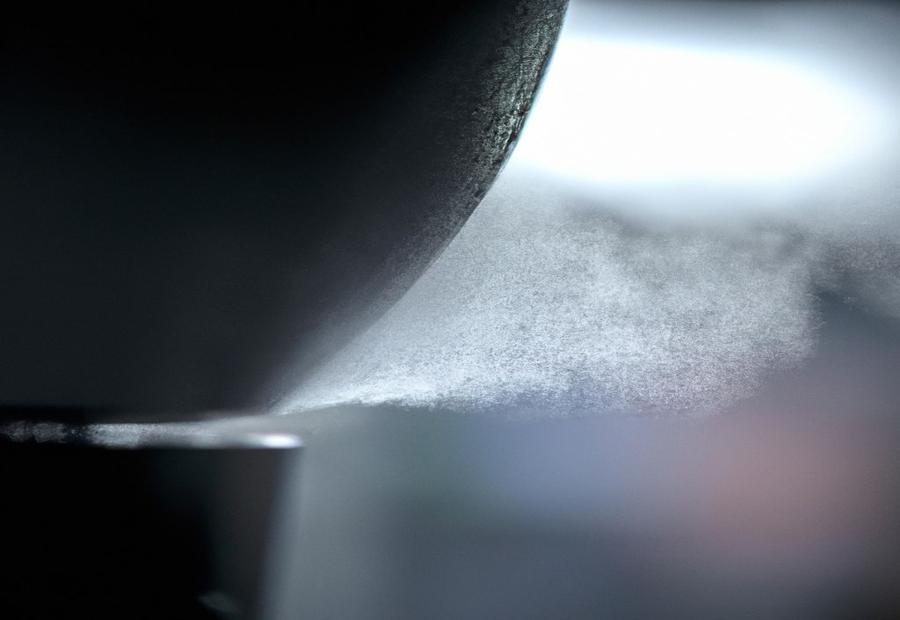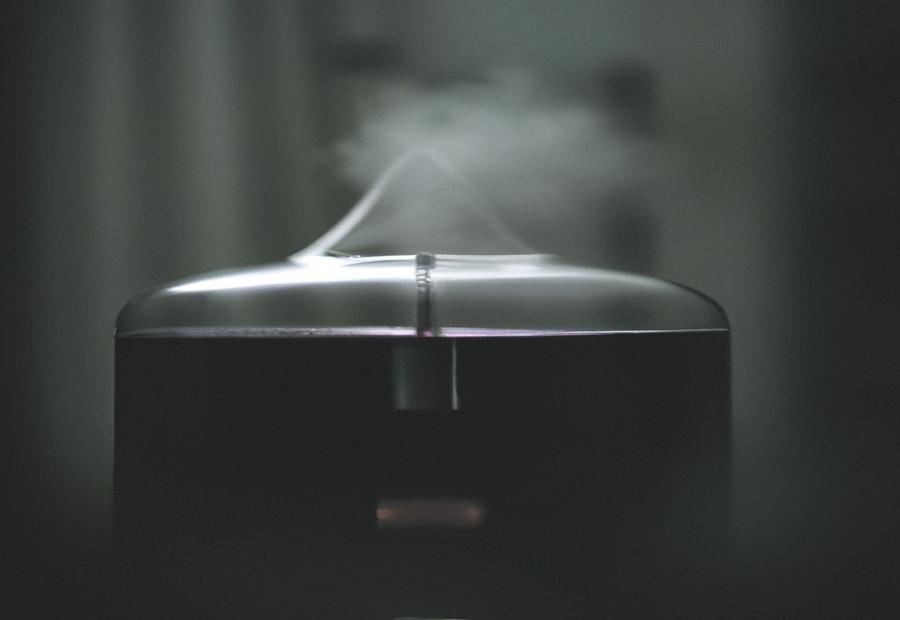Last Updated on 10 months by Francis
.jpg)
Humidifiers are widely used to add moisture to the air and improve indoor air quality. Understanding how humidifiers work and the role of water in their operation is important for maintaining their effectiveness. When a humidifier runs out of water, several consequences can occur. Let’s explore these in detail.
-
Decreased Humidity Levels: The primary function of a humidifier is to increase humidity in the surrounding environment. When it runs out of water, the desired humidity levels cannot be maintained, leading to a decrease in moisture in the air.
-
Potential Damage to the Humidifier: Operating a humidifier without water can cause damage to the device. Some models may have built-in safety features that automatically shut off the humidifier when the water runs out to prevent this.
-
Impact on Air Quality: Humidity plays a crucial role in maintaining proper air quality. When a humidifier runs out of water, the air can become drier, affecting the overall air quality in the room and potentially leading to discomfort or respiratory issues.
-
Possible Health Effects: Inadequate humidity levels can have adverse effects on health. Dry air can cause dry skin, irritated nasal passages, throat dryness, and worsen respiratory conditions such as asthma and allergies.
To prevent a humidifier from running out of water, several measures can be taken. Regularly checking water levels, using humidity control or automatic shut-off features, and using distilled water can help ensure that the humidifier operates efficiently and safely.
Proper maintenance is essential for the optimal functioning of a humidifier. Regular cleaning and disinfection of the unit, timely replacement of filters as recommended, and storing the humidifier properly when not in use are important aspects to consider.
By understanding the implications of a humidifier running out of water and implementing necessary preventive measures, you can continue to enjoy the benefits of proper humidity levels in your indoor environment.
Contents
Key takeaway:
- Decreased Humidity Levels: When a humidifier runs out of water, the humidity levels in the room decrease, which can cause discomfort and dryness for people.
- Potential Damage to the Humidifier: Running a humidifier without water can damage the device and its components, leading to reduced performance and lifespan.
- Impact on Air Quality and Health Effects: Without water, a humidifier cannot properly add moisture to the air, resulting in poor air quality and potential health issues such as dry skin, irritation, and respiratory problems.
Understanding Humidifiers
Understanding humidifiers is essential for improving air quality and comfort in a room. Humidifiers are devices that increase humidity by emitting moisture into the air. This can have various benefits for respiratory health, skin hydration, and reducing static electricity.
There are different types of humidifiers available, including evaporative, ultrasonic, and steam humidifiers. Each type has its own advantages and considerations.
Regular maintenance is crucial to keep humidifiers clean and prevent the growth of bacteria and mold. Cleaning the water tank and replacing filters every week is a general guideline, but the frequency may vary depending on the model and usage.
Monitoring and maintaining appropriate humidity levels within the range of 30-50% is important to prevent excessive moisture that can lead to mold growth or discomfort. Using a hygrometer can help measure humidity accurately.
Proper placement of the humidifier is vital for optimal moisture distribution. Placing it in a central area of the room, away from walls and furniture, provides better coverage.
The quality of water used in humidifiers can affect their performance and lifespan. It is recommended to use distilled or demineralized water to minimize mineral buildup and prevent white dust deposits.
To make the most of your humidifier, ensure proper understanding and follow the manufacturer’s instructions. If you have specific health concerns or require specialized features, consult with a professional. Remember to regularly clean and maintain your humidifier to avoid potential health risks.
How Do Humidifiers Work?

Photo Credits: Infraredforhealth.Com by Alan Rodriguez
Humidifiers are devices that help increase the humidity levels in indoor spaces. They work by emitting water vapor or steam into the air, which helps to add moisture and alleviate dryness. There are different types of humidifiers, such as evaporative, ultrasonic, and steam humidifiers.
Evaporative humidifiers use a fan to blow air through a moistened wick or filter, causing water to evaporate and humidify the air. Ultrasonic humidifiers use high-frequency vibrations to create a fine mist that is then released into the air. Steam humidifiers heat water to produce steam, which is then released into the room.
Humidifiers are beneficial in several ways. They can alleviate symptoms of dry skin, dry eyes, and dry throat. They can also reduce static electricity, which is common in dry environments. Additionally, humidifiers can help keep indoor plants healthy, as many plants thrive in higher humidity levels.
True story: A friend of mine had a humidifier in her baby’s nursery. The dry winter air was causing her baby to have dry skin and congestion. She used an ultrasonic humidifier, which emitted a cool mist into the room. The humidifier helped moisturize the air in the nursery, making it more comfortable for her baby to breathe and reducing dryness on the baby’s skin. It made a noticeable difference in her baby’s well-being and comfort during the winter months.
The Importance of Water in Humidifiers
Water is incredibly important when it comes to the proper functioning of humidifiers. The significance of water in humidifiers cannot be overstated. Here’s why:
1. Humidifiers are responsible for adding moisture to the air, but they require water in order to create that moisture. Without water, a humidifier simply cannot effectively perform its function.
2. Water plays a crucial role in humidifiers by alleviating dryness in the air. This dryness can lead to discomfort and a variety of health issues such as dry skin, irritated eyes, and respiratory problems.
3. The quality of water used in humidifiers is of utmost importance. Tap water, which may contain minerals and impurities, has the potential to be released into the air, thereby compromising the overall air quality and potentially causing damage to the humidifier over time. To prevent these issues, it is recommended to use distilled or purified water.
4. Proper water levels are vital for the efficient operation of humidifiers. Maintaining the correct water level ensures that the humidifier can generate the desired amount of moisture without any interruptions.
Pro tip: In order to enhance the effectiveness and lifespan of your humidifier, it is recommended to regularly clean and refill it with clean and pure water. By regularly cleaning and changing the water, you can prevent the buildup of bacteria and mineral deposits. This will help to ensure that your humidifier continues to function optimally.
What Happens When a Humidifier Runs Out of Water?

Photo Credits: Infraredforhealth.Com by Richard Sanchez
What exactly goes down when your trusty humidifier runs out of water? Well, in this section, we’ll uncover the consequences and impacts of this common occurrence. We’ll dive into the decreased humidity levels that ensue, the potential damage it can cause to your humidifier, and even touch upon the far-reaching effects it can have on air quality and your health. Brace yourself for an enlightening read on the untold story behind a water-deprived humidifier.
Decreased Humidity Levels
When a humidifier runs out of water, one of the immediate effects is decreased humidity levels in the surrounding area. The humidifier is no longer able to emit moisture into the air, causing the humidity level to drop. This can lead to several consequences.
- Dry air: Decreased humidity levels result in dry air, which can cause discomfort, especially for individuals with respiratory issues or dry skin.
- Increased static electricity: Dry air can also increase the build-up of static electricity, leading to unpleasant shocks and potential damage to electronic devices.
- Worsened respiratory symptoms: Dry air can exacerbate respiratory symptoms like coughing, congestion, and sore throat, especially for individuals with asthma or allergies.
- Damage to wood and furniture: Lack of humidity can cause wood to dry out and crack, as well as damage furniture, musical instruments, and other wooden items.
- Decreased plant health: Plants thrive in environments with adequate moisture, and decreased humidity levels can negatively impact their health and growth.
It is important to regularly monitor the water levels in your humidifier to ensure that it does not run out. Implementing measures such as setting up humidity control or automatic shut-off can help prevent decreased humidity levels and the associated issues.
Sarah forgot to check the water level in her humidifier for a few days. Unbeknownst to her, the humidifier ran out of water, leading to decreased humidity levels in her bedroom. She woke up the next morning with a dry throat and feeling congested. Not only that, but her wooden furniture started showing signs of drying out, with cracks appearing on the surface. Realizing the importance of maintaining proper water levels, Sarah now regularly checks her humidifier and refills it to prevent any negative effects.
Potential Damage to the Humidifier
When a humidifier runs out of water, it has the potential to cause damage to the humidifier itself. The lack of water in the humidifier can lead to the overheating of the heating element or the ultrasonic disc, which may result in damage to these components. This damage can have a negative impact on the functionality of the humidifier and may require the need for repair or replacement.
Moreover, when a humidifier runs out of water, it can also have an impact on the air quality in the surrounding area. Without water, the humidifier is unable to add moisture to the air, which leads to decreased humidity levels. This lack of moisture can cause dryness in the air, particularly for individuals who suffer from respiratory conditions or have dry skin, leading to discomfort.
To prevent potential damage to the humidifier, it is crucial to regularly check the water levels and ensure there is always enough water present. Some humidifiers come with features such as humidity control or automatic shut-off, which help prevent the humidifier from running without water. Additionally, using distilled water is recommended as it does not contain minerals or impurities that can potentially cause buildup or damage to the humidifier.
Proper maintenance of the humidifier is also essential in preventing damage. Regularly cleaning and disinfecting the humidifier helps remove any accumulated dirt or bacteria. It is also important to follow the manufacturer’s recommendations for replacing filters to ensure the humidifier operates efficiently. Lastly, storing the humidifier properly, especially when not in use, helps maintain its longevity and prevents potential damage.
By being aware of the potential damage that can occur when a humidifier runs out of water and taking proactive measures to prevent it, you can ensure the optimal performance and durability of your humidifier.
Impact on Air Quality and Health Effects
Running a humidifier without water can have a significant impact on air quality and health effects. When a humidifier runs out of water, it no longer releases moisture into the air, resulting in decreased humidity levels. This can lead to dry air, causing respiratory discomfort such as dry throat, irritated sinuses, and dry skin. Additionally, running a humidifier without water can damage the device itself, putting strain on the motor and other components. This can potentially lead to malfunctions or even permanent damage. Therefore, it is crucial to always ensure that the humidifier has sufficient water to operate properly.
Another important aspect to consider is the impact on air quality. Humidifiers help improve air quality by adding moisture to the air, which can alleviate respiratory issues and reduce allergens. However, when a humidifier runs out of water, it loses its ability to clean and moisturize the air, potentially negatively impacting air quality. This can result in worsened allergies, respiratory infections, or other health issues.
To avoid these negative consequences, it is essential to regularly check the water levels in your humidifier. Additionally, using distilled water can help minimize mineral buildup in the device and maintain air quality. By maintaining proper water levels and taking necessary precautions, you can ensure that your humidifier operates effectively, contributing to better air quality and safeguarding your health.
Preventing Humidifiers from Running Out of Water
Keep your humidifier running smoothly with these simple tips. We’re diving into the ways you can prevent your humidifier from running out of water. From regularly checking water levels to setting up humidity control or automatic shut-off features, we’ve got you covered. Plus, discover the benefits of using distilled water for optimal performance. Say goodbye to dry air and hello to a healthier, more comfortable environment with these smart humidifier practices.
Regularly Check Water Levels
Regularly checking water levels in a humidifier is crucial to ensure optimal performance and prevent potential damage. Here are the steps to follow:
- Prior to turning on the humidifier, regularly check the water level indicator or the water tank itself to determine the current water level.
- If the water level is low, make sure to refill the tank with clean, distilled water. It is advisable to avoid using tap water as it may contain minerals that can cause buildup or affect the functionality of the humidifier over time.
- It is important to repeat this process every day or as recommended by the manufacturer in order to ensure a consistent supply of water for the humidifier.
Regularly checking water levels helps in maintaining proper humidity levels in the air and prevents the humidifier from running out of water, which can result in decreased humidity levels and potential damage to the device.
Did you know? Maintaining adequate water levels in a humidifier can help prevent dry skin, congestion, and other discomforts caused by low humidity levels in the environment.
Set Up Humidity Control or Automatic Shut-Off
To Set Up Humidity Control or Automatic Shut-Off for your humidifier, follow these steps:
- Refer to the humidifier’s user manual to understand if it has a built-in humidity control or automatic shut-off feature.
- If the humidifier has a humidity control feature, locate the control panel or settings on the device.
- Adjust the humidity control to your desired level, usually between 30% to 50% for a comfortable indoor environment.
- For an automatic shut-off feature, check if the humidifier has a water level sensor or a timer.
- If it has a water level sensor, ensure it is properly calibrated and functioning.
- If it has a timer, set the desired run time for the humidifier.
- Test the humidity control or shut-off feature by monitoring the humidity levels in the room and observing if the humidifier turns off when the desired humidity is reached or when the water level is low.
By setting up humidity control or automatic shut-off, you can maintain appropriate humidity levels, prevent excessive moisture, and avoid running the humidifier without water. This ensures optimal performance, extends the lifespan of the device, and promotes healthier air quality in your living space. Remember to regularly clean and maintain the humidifier according to the manufacturer’s instructions for optimal functioning.
Use Distilled Water
Using distilled water in humidifiers offers several benefits for optimal performance and maintenance. Distilled water helps prevent mineral buildup, improves air quality, prolongs the device’s lifespan, reduces maintenance requirements, and provides health benefits.
- Distilled water is free from minerals and impurities that can accumulate in the humidifier over time, preventing mineral buildup and ensuring the device’s effectiveness.
- When distilled water is used, it does not release minerals or impurities into the air, resulting in clean and pure moisture that promotes better air quality in the surrounding area.
- By using distilled water, the risk of mineral deposits and scale formation in the humidifier is minimized, reducing the likelihood of damage and extending the device’s lifespan. This helps save money on repairs or replacement.
- Because distilled water does not contain minerals, it leaves less residue in the humidifier, reducing the frequency of cleaning and maintenance. This convenience is especially beneficial for busy individuals.
- Distilled water is free from contaminants, making it a safe choice for individuals with respiratory conditions or allergies. Using distilled water in the humidifier helps minimize the release of potentially harmful substances into the air.
Tips for Proper Humidifier Maintenance
Maintaining your humidifier properly is key to ensuring its longevity and optimal performance. In this section, we’ll reveal some valuable tips to keep your humidifier in top shape.
Discover how regularly cleaning and disinfecting your unit can prevent bacterial growth and improve air quality. Learn about the importance of replacing filters as recommended to keep your humidifier functioning efficiently.
We’ll also explore the correct storage methods to protect your device during periods of non-use. Get ready to extend the lifespan of your humidifier with these essential maintenance practices.
Regularly Clean and Disinfect the Humidifier
To maintain a clean and healthy environment, it is important to regularly clean and disinfect your humidifier. Here are the steps to follow:
- Regularly turn off and unplug the humidifier.
- Regularly empty any remaining water from the tank.
- Regularly dismantle the humidifier by removing the water tank and any other detachable parts.
- Regularly fill a sink or basin with warm water and add a small amount of mild dish soap.
- Regularly place the removable parts of the humidifier into the soapy water and let them soak for a few minutes.
- Regularly use a soft brush or cloth to scrub the interior and exterior of the water tank to remove any buildup or residue.
- Regularly rinse all the parts thoroughly with clean water to remove any soap residue.
- If your humidifier has a filter, regularly replace it if necessary or clean it according to the manufacturer’s instructions.
- Regularly wipe the exterior of the humidifier with a clean cloth to remove any dust or dirt.
- Regularly allow all the parts to air dry completely before reassembling the humidifier.
- Regularly, once dry, reattach the water tank and any other parts and ensure they are securely in place.
- Regularly refill the tank with clean water and plug in the humidifier.
- Regularly repeat this cleaning and disinfecting process at least once a week to prevent the growth of bacteria and molds.
By regularly cleaning and disinfecting your humidifier, you can ensure that it functions properly and provides clean, healthy air in your home.
Replace Filters as Recommended
To ensure optimal performance and air quality, it is essential to regularly replace filters as recommended in your humidifier. Here are the steps to follow:
- Step 1: Refer to the manufacturer’s instructions or user manual to determine the recommended frequency for replacing filters as recommended.
- Step 2: Turn off and unplug the humidifier to ensure safety during the filter replacement process.
- Step 3: Carefully remove the old filter from the humidifier. Dispose of it according to the proper waste disposal guidelines.
- Step 4: Take out the new filter from its packaging, ensuring it is the correct size and type for your specific humidifier model.
- Step 5: Insert the new filter into the designated compartment or slot, making sure it is properly aligned and fits securely.
- Step 6: Close the compartment or slot securely, ensuring there are no gaps or loose parts.
- Step 7: Plug in the humidifier and turn it on. Monitor its performance to ensure the new filter is functioning effectively.
By following these steps and replacing filters as recommended by the manufacturer, you will ensure that your humidifier continues to provide optimal air moisture and quality.
True story: Susan had been using her humidifier for over a year without replacing filters as recommended. She noticed that the air quality in her room had decreased, and her allergies were worsening. After consulting the humidifier’s manual, she discovered that the filters should be replaced every six months. Susan immediately ordered new filters and followed the replacement steps. Once the new filters were in place, she noticed a significant improvement in air quality, and her allergies subsided. From that point forward, Susan made sure to replace filters as recommended, ensuring her humidifier produced clean and healthy air.
Store the Humidifier Properly
To store the humidifier properly and ensure its longevity, follow these simple steps:
- Empty the water tank: Before storing the humidifier, make sure to empty the water tank completely. This prevents any stagnant water from accumulating and causing mold or bacterial growth.
- Clean the humidifier: Thoroughly clean the humidifier before storing it. Disassemble the parts and clean them with mild soap and water, or according to the manufacturer’s instructions. Rinse and dry the parts completely to prevent any moisture buildup.
- Replace filters if needed: Check if the humidifier has any filters and replace them if necessary. Dirty or clogged filters can affect the performance of the humidifier and lead to poor air quality.
- Ensure the unit is dry: Before storing the humidifier, ensure that all the parts are completely dry. Wipe down the exterior and interior of the humidifier to remove any moisture.
- Find a cool, dry place: Store the humidifier in a cool, dry place to prevent any damage or the growth of mold or mildew. Avoid storing it near heat sources or in direct sunlight.
- Cover or wrap the humidifier: If the humidifier has delicate parts or is prone to dust accumulation, consider covering or wrapping it with a clean cloth or plastic cover to protect it during storage.
By following these steps, you can store the humidifier properly and ensure that it remains in good condition for future use.
Some Facts About What Happens When a Humidifier Runs Out of Water:
- ✅ Running a humidifier without water will result in the release of dry air. (Source: humidifiercompare.com)
- ✅ Humidifiers are designed to shut down when they run out of water, but the auto-shut off feature can fail. (Source: humidifiercompare.com)
- ✅ It is not recommended to run a humidifier without water as it is designed to operate with water in its tank. (Source: shop.mirohome.com)
- ✅ Running a humidifier without water prevents stagnant water and the formation of mold, bacteria, viruses, and contaminants. (Source: shop.mirohome.com)
- ✅ Regular cleaning of humidifiers with white vinegar is important to prevent the spread of mold. (Source: shop.mirohome.com)
Frequently Asked Questions
What happens when a humidifier runs out of water?
When a humidifier runs out of water, it will stop working and release dry air instead of moist air.
Can you run a humidifier without water?
No, it is not recommended to run a humidifier without water as it is designed to operate with water in its tank.
Do humidifiers turn off automatically when they run out of water?
Most modern humidifiers have an auto shut-off feature that turns off the humidifier when it runs out of water, ensuring safety and preventing damage.
How long can a humidifier run without refilling?
The running time of a humidifier without refilling depends on factors such as tank size, mist production settings, and the relative humidity level in the room. It is recommended to check the water level regularly and refill as needed.
What are the consequences of leaving a humidifier on without water?
Leaving a humidifier on without water can cause cool mist humidifiers to blow out hot air and warm mist humidifiers to overheat, potentially resulting in damage or even fire hazards.
Are there any precautions to take to prevent a humidifier from running without water?
To prevent a humidifier from running without water, it is essential to choose a humidifier with an automatic shut-off function. Regularly checking and filling the water tank, setting reminders, and using distilled water can also help ensure the humidifier never runs out of water and operates safely.

.jpg)
.jpg)





